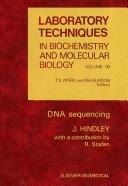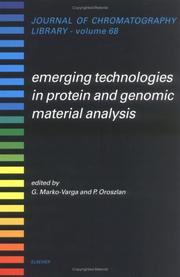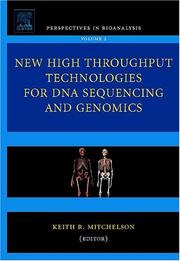| Listing 1 - 10 of 14 | << page >> |
Sort by
|
Periodical
Abstract | Keywords | Export | Availability | Bookmark
 Loading...
Loading...Choose an application
- Reference Manager
- EndNote
- RefWorks (Direct export to RefWorks)
DNA-ligand interactions --- Base Sequence. --- DNA. --- Molecular Biology.

ISBN: 0444804978 9780080858791 0080858791 9780444804976 0444803858 9786611756383 1281756385 9780444803856 Year: 1988 Volume: 10 Publisher: Amsterdam Elsevier biomedical
Abstract | Keywords | Export | Availability | Bookmark
 Loading...
Loading...Choose an application
- Reference Manager
- EndNote
- RefWorks (Direct export to RefWorks)
This volume provides a comprehensive description of the principles and methods used in DNA sequencing. Following a detailed introduction the chapters are: DNA sequencing; Chain terminator sequencing; Primed synthesis methods applied to DNA fragments cloned into phage M13; DNA sequencing by the Maxam-Gilbert chemical procedure; Computer methods for DNA sequencers; Appendices including contractions and special terms, cloning vectors, commercially available restriction endonucleases, and autoradiography.
Analytical biochemistry --- Molecular biology --- Dna --- Nucleotide sequence. --- Base sequence. --- Dna. --- Analysis. --- DNA --- Nucleotide sequence --- Analysis, Nucleic acid sequence --- Analysis, Nucleotide sequence --- Base sequence (Nucleic acids) --- DNA sequence --- Nucleic acid sequence analysis --- Nucleotide sequence analysis --- RNA sequence --- Sequence, Nucleotide --- Nucleic acids --- Nucleotides --- Sequence alignment (Bioinformatics) --- Analysis
Book
ISBN: 1281046302 9786611046309 0080532705 Year: 1998 Publisher: San Diego : Academic Press,
Abstract | Keywords | Export | Availability | Bookmark
 Loading...
Loading...Choose an application
- Reference Manager
- EndNote
- RefWorks (Direct export to RefWorks)
The Guide to Human Genome Computing is invaluable to scientists who wish to make use of the powerful computing tools now available to assist them in the field of human genome analysis. This book clearly explains access and use of sequence databases, and presents the various computer packages used to analyze DNA sequences, measure linkage analysis, compare and align DNA sequences from different genes or organisms, and infer structural and functional information about proteins from sequence data.This Second Edition contains completely updated material. Rather than a revision of the pr
Human gene mapping --- Nucleotide sequence --- Data processing. --- Computer network resources. --- Analysis, Nucleic acid sequence --- Analysis, Nucleotide sequence --- Base sequence (Nucleic acids) --- DNA sequence --- Nucleic acid sequence analysis --- Nucleotide sequence analysis --- RNA sequence --- Sequence, Nucleotide --- Human chromosome mapping --- Human genome mapping --- Mapping, Human gene --- Nucleic acids --- Nucleotides --- Sequence alignment (Bioinformatics) --- Gene mapping --- Analysis

ISBN: 9780124371781 0124371787 9786611119164 1281119164 0080531261 9780080531267 9781281119162 6611119167 Year: 2004 Publisher: Amsterdam Boston Elsevier/Academic Press
Abstract | Keywords | Export | Availability | Bookmark
 Loading...
Loading...Choose an application
- Reference Manager
- EndNote
- RefWorks (Direct export to RefWorks)
Now in two-colour throughout, the fourth edition of Eukaryotic Transcription Factors has been completely rewritten and restructured to take into account the tremendous advances in our understanding of transcription factors and the mechanisms by which they act. Considerable emphasis has been given to the interaction between transcription factors and chromatin structure. Also included is an entirely new section on the mediator complex and expansion of the space devoted to co-activators and co-repressors.This book is essential reading for all those who wish to understand the impac
Eukaryotic Cells. --- Gene Expression Regulation. --- Transcription Factors. --- Transcription, Genetic. --- Transcription factors. --- Genetic transcription --- Eukaryotic cells. --- Facteurs de transcription --- Transcription génétique --- Cellules eucaryotes --- Regulation. --- Régulation --- Genetic transcription. --- Genetic regulation --- Genetic transcription factors --- Proteins --- Transcription factors --- Eukaryotic cells --- MOLECULAR STRUCTURE --- BASE SEQUENCE --- DNA-BINDING PROTEINS --- GENETIC PREDISPOSITION TO DISEASE --- TRANSCRIPTION, GENETIC --- DNA-DIRECTED RNA POLYMERASES --- CHROMATIN --- TRANSCRIPTION FACTORS --- ULTRASTRUCTURE
Book
ISBN: 0128018410 0128017392 9780128018415 9780128017395 Year: 2016 Publisher: Amsterdam, [Netherlands] : Academic Press,
Abstract | Keywords | Export | Availability | Bookmark
 Loading...
Loading...Choose an application
- Reference Manager
- EndNote
- RefWorks (Direct export to RefWorks)
Nucleotide sequence. --- Medical genetics. --- Clinical genetics --- Diseases --- Heredity of disease --- Human genetics --- Medical sciences --- Pathology --- Genetic disorders --- Analysis, Nucleic acid sequence --- Analysis, Nucleotide sequence --- Base sequence (Nucleic acids) --- DNA sequence --- Nucleic acid sequence analysis --- Nucleotide sequence analysis --- RNA sequence --- Sequence, Nucleotide --- Nucleic acids --- Nucleotides --- Sequence alignment (Bioinformatics) --- Genetic aspects --- Analysis

ISBN: 1281055018 9786611055011 0080530842 044450964X 9780080530840 9780444509642 Year: 2003 Publisher: Amsterdam ; Boston : Elsevier,
Abstract | Keywords | Export | Availability | Bookmark
 Loading...
Loading...Choose an application
- Reference Manager
- EndNote
- RefWorks (Direct export to RefWorks)
It is widely recognized that analytical technologies and techniques are playing a pioneering role in a range of today's foremost challenging scientific endeavours, including especially biological and biomedical research. Worthy of mention, for example, are the role that high performance separation techniques played in mapping the human genome and the pioneering work done within mass spectrometry. It is also apparent that state-of-the-art pharmaceutical and biomedical research is the major driving force of the development of new analytical techniques. Advancements in genomics research h
Proteins --- Nucleotide sequence. --- Chromatographic analysis. --- Mass spectrometry. --- Analysis. --- Mass spectra --- Mass spectrograph --- Mass spectroscopy --- Mass spectrum analysis --- Analysis, Chromatographic --- Chromatography --- Analysis, Nucleic acid sequence --- Analysis, Nucleotide sequence --- Base sequence (Nucleic acids) --- DNA sequence --- Nucleic acid sequence analysis --- Nucleotide sequence analysis --- RNA sequence --- Sequence, Nucleotide --- Mass (Physics) --- Nuclear spectroscopy --- Spectrum analysis --- Chemistry, Analytic --- Phase partition --- Nucleic acids --- Nucleotides --- Sequence alignment (Bioinformatics) --- Analysis --- Analytical chemistry
Book
ISBN: 0128133368 012813335X 9780128133361 9780128133354 Year: 2019 Publisher: Waltham, MA : Academic Press, an imprint of Elsevier,
Abstract | Keywords | Export | Availability | Bookmark
 Loading...
Loading...Choose an application
- Reference Manager
- EndNote
- RefWorks (Direct export to RefWorks)
Clinical Genome Sequencing: Psychological Aspects thoroughly details key psychological factors to consider while implementing genome sequencing in clinical practice, taking into account the subtleties of genetic risk assessment, patient consent and best practices for sharing genomic findings. Chapter contributions from leading international researchers and practitioners cover topics ranging from the current state of genomic testing, to patient consent, patient responses to sequencing data, common uncertainties, direct-to-consumer genomics, the role of genome sequencing in precision medicine, genetic counseling and genome sequencing, genome sequencing in pediatrics, genome sequencing in prenatal testing, and ethical issues in genome sequencing. Applied clinical case studies support concept illustration, making this an invaluable, practical reference for this important and multifaceted topic area within genomic medicine.
Gene mapping. --- Whole Genome Sequencing --- Precision Medicine --- ethics. --- psychology. --- Chromosome mapping --- Genetic mapping --- Genome mapping --- Linkage mapping (Genetics) --- Mapping, Gene --- Genetics --- Technique --- Nucleotide sequence --- Human gene mapping --- Genetic counseling --- Genetic Counseling --- Genetic Testing --- Base Sequence --- Moral and ethical aspects. --- Psychological aspects. --- psychology

ISBN: 1280962682 9786610962686 0080471285 0444522239 9780444522238 9780080471280 Year: 2006 Publisher: Boston, MA : Elsevier B. V.,
Abstract | Keywords | Export | Availability | Bookmark
 Loading...
Loading...Choose an application
- Reference Manager
- EndNote
- RefWorks (Direct export to RefWorks)
Since the independent invention of DNA sequencing by Sanger and by Gilbert 30 years ago, it has grown from a small scale technique capable of reading several kilobase-pair of sequence per day into today's multibillion dollar industry. This growth has spurred the development of new sequencing technologies that do not involve either electrophoresis or Sanger sequencing chemistries. Sequencing by Synthesis (SBS) involves multiple parallel micro-sequencing addition events occurring on a surface, where data from each round is detected by imaging. New High Throughput Technologies for DNA Se
Nucleotide sequence --- Genomics --- Genetic engineering --- Technological innovations. --- Designed genetic change --- Engineering, Genetic --- Gene splicing --- Genetic intervention --- Genetic surgery --- Genetic recombination --- Biotechnology --- Transgenic organisms --- Genome research --- Genomes --- Molecular genetics --- Analysis, Nucleic acid sequence --- Analysis, Nucleotide sequence --- Base sequence (Nucleic acids) --- DNA sequence --- Nucleic acid sequence analysis --- Nucleotide sequence analysis --- RNA sequence --- Sequence, Nucleotide --- Nucleic acids --- Nucleotides --- Sequence alignment (Bioinformatics) --- Research --- Analysis
Book
ISBN: 0128205199 0128205202 9780128205204 9780128205198 Year: 2021 Publisher: London : Academic Press,
Abstract | Keywords | Export | Availability | Bookmark
 Loading...
Loading...Choose an application
- Reference Manager
- EndNote
- RefWorks (Direct export to RefWorks)
Human genetics --- DNA --- Nucleotide sequence. --- Genetic disorders. --- Variation. --- Analysis. --- Diseases --- Medical genetics --- Congenital diseases --- Disorders, Genetic --- Disorders, Inherited --- Genetic diseases --- Hereditary diseases --- Inherited diseases --- Nucleic acids --- Nucleotides --- Sequence alignment (Bioinformatics) --- Analysis, Nucleic acid sequence --- Analysis, Nucleotide sequence --- Base sequence (Nucleic acids) --- DNA sequence --- Nucleic acid sequence analysis --- Nucleotide sequence analysis --- RNA sequence --- Sequence, Nucleotide --- Variation (Biology) --- Genetic variation in humans --- Analysis
Book
ISBN: 1281032646 9786611032647 008053239X Year: 1999 Publisher: San Diego, Calif. : Academic Press,
Abstract | Keywords | Export | Availability | Bookmark
 Loading...
Loading...Choose an application
- Reference Manager
- EndNote
- RefWorks (Direct export to RefWorks)
Computer access is the only way to retrieve up-to-date sequences and this book shows researchers puzzled by the maze of URLs, sites, and searches how to use internet technology to find and analyze genetic data. The book describes the different types of databases, how to use a specific database to find a sequence that you need, and how to analyze the data to compare it with your own work. The content also covers sequence phenotype, mutation, and genetic linkage databases; simple repetitive DNA sequences; gene feature identification; and prediction of structure and function of proteins from
Genetics --- Nucleotide sequence --- Amino acid sequence --- Data processing. --- Amino acid sequence analysis --- Analysis, Amino acid sequence --- Peptide sequence --- Peptide sequencing --- Protein sequence --- Protein sequencing --- Sequence, Amino acid --- Analysis, Nucleic acid sequence --- Analysis, Nucleotide sequence --- Base sequence (Nucleic acids) --- DNA sequence --- Nucleic acid sequence analysis --- Nucleotide sequence analysis --- RNA sequence --- Sequence, Nucleotide --- Amino acids --- Proteins --- Sequence alignment (Bioinformatics) --- Nucleic acids --- Nucleotides --- Biology --- Embryology --- Mendel's law --- Adaptation (Biology) --- Breeding --- Chromosomes --- Heredity --- Mutation (Biology) --- Variation (Biology) --- Analysis
| Listing 1 - 10 of 14 | << page >> |
Sort by
|

 Search
Search Feedback
Feedback About UniCat
About UniCat  Help
Help News
News